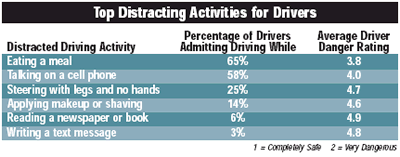They may not think it’s safe, but most Washington drivers admit to keeping one eye and one hand on a meal while driving, according to a recently released PEMCO Insurance poll on driver distraction.
Eating a meal turned out to be the most-common distracting activity—65 percent of drivers stated they eat while driving. Fifty-eight percent of drivers acknowledged they talk on a cell phone while driving. Drivers also thought both the activities were unsafe, along with several other common distracted driving activities.
The poll of 600 Washington residents also asked drivers to rate the danger of these common distracted driving activities. Drivers rated each activity on a scale from one to five, with one being “completely safe” and five being “very dangerous.”

“We found that when drivers eat food or call a friend, they do so despite thinking it’s dangerous,” said Jon Osterberg, PEMCO Insurance spokesperson. “Our goal is to help drivers understand that when they do that, they’re going against their better judgment.”
The poll showed drivers admit to other distracting activities in varying amounts, including applying makeup or shaving, reading a newspaper or book, steering with their legs and writing a text message.
Drivers thought reading a newspaper or book while driving was the most-dangerous distracted driving activity, with drivers rating it a 4.9 out of 5 on the danger scale. Drivers also felt that writing a text message while driving was particularly dangerous, rating it a 4.8.
Drivers aware of distraction on the road
Motorists handle dozens of distractions every time they drive, from conversations with passengers to music on the radio to roadside events. PEMCO polled drivers to learn what they perceive to be the most dangerous distractions.
No distracted driving activity received a “safe” rating, and six common distracted driving activities scored an average of 4.5 out of 5 on the danger scale.
“Drivers’ opinions draw heavily on personal experience,” said Osterberg. “It’s reasonable to believe that many have tried eating or using a cell phone while driving and decided it’s dangerous.”
Downplaying danger of more-common distractions?
The poll showed a significant trend: the more drivers admitted to performing a distracting activity, the less dangerous they saw the activity. PEMCO sees danger in any type of driving distraction. PEMCO encourages drivers to take responsibility for their driving habits and decide for themselves which habits are safe.
“Let your own common sense dictate what’s safe and what’s distracting,” said Osterberg. “Don’t fall into that ‘group mentality’ and think that eating while driving must be safe, just because you see so many people do it. Even a second or two of distraction can be dangerous. We see it all the time with rear-end collisions.”
Modern conveniences – the culprit?
A majority of Washington drivers admitted to eating meals and talking on the phone while driving, tying the most common distractions to two modern conveniences: take-out windows and cell phones.
“Eating a fast-food meal behind the wheel used to be less common, and not that long ago, talking on the phone while driving was impossible,” said Osterberg. “Technology changed that. Drivers today should ask themselves, does can do equate with should do?”
PEMCO offers these tips for drivers tempted to eat and drive:
If you know you’ll be stopping for a quick bite on the trip, try to leave a little earlier to allow time to eat away from the car.
If you pick up food from a drive-through, take a few extra minutes to park in the restaurant lot and eat. “You’ll be safer, and you’ll enjoy your food more,” said Osterberg.
If you’re traveling with someone, take turns eating and driving.
For cell phones, PEMCO’s recommendation is simple: don’t use one while driving. If you must, use a hands-free device to reduce distractions, or pull over when making or taking a call.
Large contributor to accidents
The National Highway Traffic Safety Administration estimates that driver distraction contributes to between 20 and 30 percent of all crashes.
Osterberg notes that the greatest danger comes when distractions combine with changing road conditions: you’re eating or talking on a cell phone when the unexpected happens—another driver changes lanes, brakes suddenly, or a sharp curve appears.
“If you’re trying to find that glob of mustard you dropped, or you’re looking at your phone keypad, you’re not prepared to deal with changes on the roadway,” said Osterberg. “Distractions lead to crashes.”
About the poll
PEMCO Insurance commissioned the independent, statewide phone survey that asked Washington drivers if they engaged in common distracted driving activities, and asked them to rate the safety of those activities from one (completely safe) to five (very dangerous).
Market Trends Inc. of Seattle conducted the opinion monitor consisting of 600 interviews with Washington state residents. All interviews were conducted under the direction of Market Trends’ telephone interviewing facilities in Seattle, Wash. Respondents were selected at random, using the random digit dialing method, and ZIP code quotas represented the respective Washington county populations.
The sample size of 600 respondents yields an accuracy of +/- 4 percent at the 95 percent confidence level. In other words, if this study was conducted 100 times, in 95 instances the data will not vary by more than +/- 4 percent.
Copies of the full results of the poll are available upon request.
Topics Personal Auto Washington
Was this article valuable?
Here are more articles you may enjoy.


 Consumer Acceptance of Telematics Widens, Says Survey
Consumer Acceptance of Telematics Widens, Says Survey  Florida OIR Triples the Size of Citizens’ Rate Decrease
Florida OIR Triples the Size of Citizens’ Rate Decrease  Adjusters Launch ‘CarFax for Insurance Claims’ to Vet Carriers’ Damage Estimates
Adjusters Launch ‘CarFax for Insurance Claims’ to Vet Carriers’ Damage Estimates  AIG Announces Strategic Investment Partnership of Up to $3.5B With CVC
AIG Announces Strategic Investment Partnership of Up to $3.5B With CVC 


